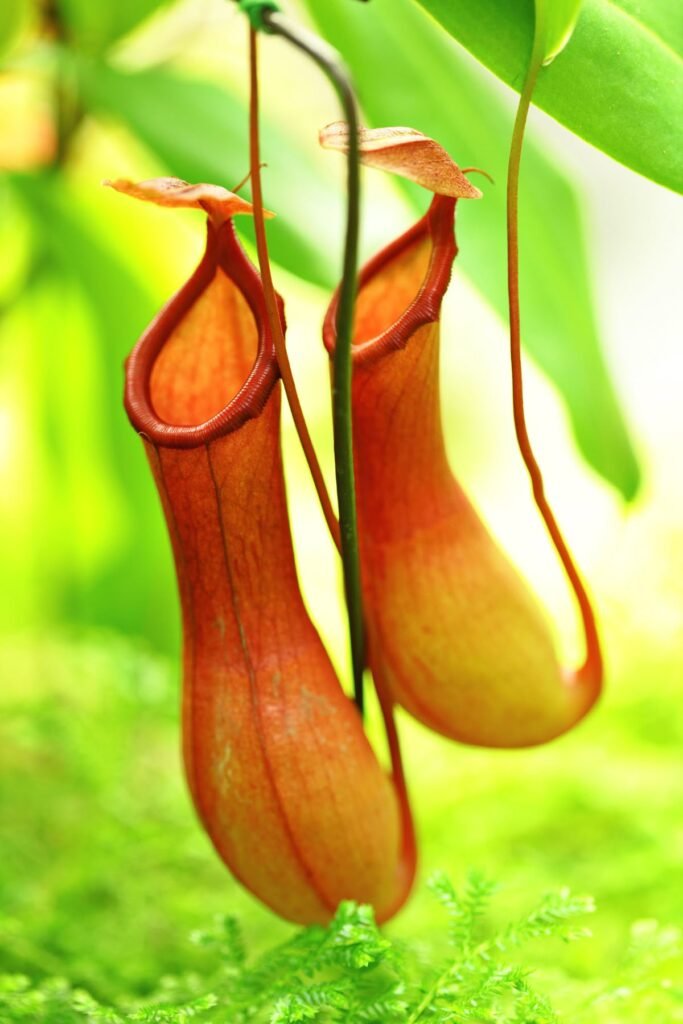The pitcher plant is one of nature’s most fascinating creations. Unlike ordinary plants, These plants are carnivorous,they capture and digest insects inside their tubular leaves, which look like small pitchers. These plants are not only unique but also make striking additions to your garden or indoor plant collection.
But pitcher plants are different from regular houseplants. They need special conditions to thrive. In this guide, we’ll explain everything you need to know about pitcher plant care—from light and watering needs to soil, feeding, and common problems.

Table of Contents
🌞 Light Requirements for Pitcher Plants
- These plants love plenty of light, which is essential for healthy growth and for developing their colorful pitchers.
- Outdoor care: Place them in full sun (at least 6–8 hours daily).
- Indoor care: Keep them on a sunny windowsill or under a grow light for 12–14 hours a day.
- Without enough light, the plant will produce weak or no pitchers.
💡 Tip: If growing indoors, south-facing windows are best.
💧 Watering the Pitcher Plant
These plants are very sensitive to water quality. Unlike other houseplants, they cannot tolerate minerals and chemicals.
- Use only rainwater, distilled water, or reverse osmosis (RO) water.
- Keep the soil consistently moist but not soggy.
- For outdoor pitcher plants (like Sarracenia), keep the pot standing in a shallow tray of water during summer.
- Never let the soil completely dry out.
⚠️ Avoid tap water — it contains minerals that can harm the plant.
🌱 Best Soil for Pitcher Plant
- These plants are adapted to grow in poor, nutrient-deficient soils. Using rich soil or fertilizers can actually kill them.
- Best soil mix: 1 part sphagnum moss + 1 part perlite or sand.
- Avoid garden soil, compost, or potting mix with fertilizer.
- Always repot in spring every 1–2 years to refresh the soil and prevent compaction.
🌡️ Temperature and Humidity Needs
- Since These plants are native to tropical and subtropical regions, they enjoy warm and humid conditions.
- Ideal temperature: 65°F–85°F (18°C–29°C).
- Some hardy pitcher plant varieties (like Sarracenia) can tolerate cooler weather, but tropical Nepenthes need consistent warmth.
- Humidity: 60–80% is ideal. If grown indoors, use a humidity tray or room humidifier.
🐜 Feeding the Pitcher Plant
- These plants get nutrients by digesting insects that fall into their pitchers.
- Outdoors, they catch their own food (ants, flies, gnats).
- Indoors, you can feed them occasionally with small insects like dried mealworms, ants, or crickets.
- Do not overfeed. One insect per pitcher every few weeks is enough.
- Never use chemical fertilizers inside the pitchers—it can burn the plant.
💡 Tip: If your plant isn’t catching enough bugs, place it outdoors during summer for natural feeding.
🌸 Fertilizer and Growth Tips
Unlike other carnivorous plants, these plants don’t need traditional fertilizer in their soil. However, you can give them a little boost:
- Use a very diluted orchid fertilizer or carnivorous plant fertilizer once a month, applied as a foliar spray on leaves (not soil).
- Stop fertilizing during dormancy (winter).
❄️ Dormancy Care (For Temperate Varieties)
Some pitcher plants, especially Sarracenia, need a winter dormancy period to rest.
- In winter, reduce watering slightly but keep soil damp.
- Place the plant in a cool area (40–55°F / 4–13°C) for 3–4 months.
- Resume normal care in spring when new growth appears.
Tropical pitcher plants (Nepenthes) do not require dormancy.
✂️ Pruning and Maintenance
- Remove dead pitchers and brown leaves to encourage new growth.
- Trim old pitchers at the base with clean scissors.
- Keep the plant clean and free of fungus by avoiding overcrowding.
⚠️ Common Problems and Solutions
- Pitchers turning brown → Normal aging, but also could mean low humidity or too much direct hot sun.
- No pitchers forming → Not enough light or improper watering.
- Shriveled leaves → Soil too dry; increase watering.
- Pests → Rare, but mealybugs or aphids may attack. Use insecticidal soap or neem oil spray.
🌿 Benefits of Pitcher Plants
- Natural pest control – they trap insects.
- Educational value – perfect for teaching kids about unique plants.
- Decorative – striking appearance for gardens, balconies, and windows.
- Conversation starter – an exotic plant that fascinates visitors.
Final Thoughts 🌱
- These plants are not your average houseplant. With its insect-catching pitchers and exotic look, it’s both beautiful and useful. Remember: give it plenty of sunlight, pure water, the right soil, and high humidity. Avoid fertilizers in the soil, and let nature do the feeding.
- Whether you grow tropical Nepenthes or hardy Sarracenia, pitcher plants will bring a touch of wild beauty to your home or garden. With proper care, they will thrive and reward you with fascinating, one-of-a-kind growth.
